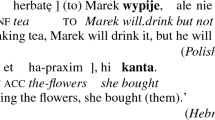Abstract
This paper addresses the question of whether the preverbal even (VP-even) embedded in a nonfinite clause can take wide scope (e.g., Bill refused to even drink WATER). The paper presents novel evidence for wide scope VP-even that is independent of the presuppositions of even. The evidence is based on examples of antecedent-contained deletion (ACD), where embedded VP-even associates with a nominal constituent (or part of it) that raises out of the embedded clause via quantifier raising. Assuming that even must c-command the focus that it associates with, the case at issue forces VP-even to have wide scope, and further shows that VP-even in NPI-licensing contexts is not necessarily an NPI.
Similar content being viewed by others
References
Beaver David (2001) Presupposition and assertion in dynamic semantics. CSLI Publications, Stanford
Bouton, Lawrence (1970) Antecedent-contained proforms. In Proceedings of CLS 6, 154-167. Chicago Linguistic Society, Chicago
Büring Daniel, Katharina Hartmann (2001) The syntax and semantics of focus-sensitive particles in German. Natural Language and Linguistic Theory 19: 229–281
Chierchia Gennaro. (2004) Scalar implicatures, polarity phenomena, and the syntax/pragmatics interface. In: Belletti A (eds) Structures and beyond. Oxford University Press, Oxford, pp 39–65
Chomsky Noam (1976) Conditions on rules of grammar. Linguistic Analysis 2: 303–350
Fiengo Robert, Robert May (1994) Indices and identity. MIT Press, Cambridge, Mass
Geurts Bart, Robvan der Sandt (2004) Interpreting focus. Theoretical Linguistics 30: 1–44
Giannakidou Anastasia (2007) The landscape of EVEN items. Natural Language and Linguistic Theory 25: 39–81
Guerzoni, Elena. 2003. Why even ask? On the pragmatics of questions and the semantics of answers. Ph.D. dissertation, MIT.
Guerzoni Elena (2006) Intervention effects on NPIs and feature movement: Towards a unified account of intervention. Natural Language Semantics 14: 359–398
Heim, Irene (1983) On the projection problem for presuppositions. In Proceedings of WCCFL 2, 114–125. CSLI Publications, Stanford
Heim Irene (1984) A note on negative polarity and downward entailingness. In: Jones C., Sells P (eds) Proceedings of NELS 14. GLSA Publications, Amherst, pp 98–107
Herburger Elena (2003) A note on Spanish ni siquiera, even, and the analysis of NPIs. Probus 15: 237–256
Hoeksema Jack, Hotze Rullmann (2001) Scalarity and polarity: A study of scalar adverbs as polarity items. In: Hoeksema J., Rullmann H., Sanchez-Valencia V., Wouden T (eds) Perspectives on negation and polarity items. Benjamins, Amsterdam, pp 129–171
Horn, Laurence. 1972. On the semantic properties of logical operators in English. PhD dissertation, University of California at Los Angeles.
Jackendoff Ray (1972) Semantic interpretation in generative grammar. MIT Press, Cambridge, Mass
Kadmon Nirit (2001) Formal pragmatics: Semantics, pragmatics, presupposition, and focus. Blackwell, Oxford
Karttunen Lauri (1973) Presuppositions of compound sentences. Linguistic Inquiry 4: 169–194
Karttunen Lauri, Stanley Peters (1979) Conventional implicature. In: Oh C.K., Dinneen D.A (eds) Syntax and semantics 11: Presuppositions. Academic Press, New York, pp 1–55
Kempson Ruth M (1975) Presupposition and the delimitation of semantics. Cambridge University Press, Cambridge
Kennedy Christopher (1997) Antecedent-contained deletion and the syntax of quantification. Linguistic Inquiry 28: 662–288
King Jeffrey (2001) Complex demonstratives: A quantificational account. MIT Press, Cambridge, Mass
König Ekkehard (1991) The meaning of focus particles. Routledge, London
Krifka Manfred (1991) A compositional semantics for multiple focus constructions. In: Jacobs J (eds) Informationsstruktur und Grammatik, Sonderheft der Linguistischen Berichte. Opladen, Westdentscher Verlag, pp 17–53
Krifka Manfred (1995) The semantics and pragmatics of polarity items. Linguistic Analysis 25: 1–49
Krifka Manfred (2006) Association with focus phrases. In: Molnar V., Winkler S (eds) The architecture of focus. Mouton de Gruyter, Berlin, pp 105–136
Lahiri Utpal (1998) Focus and negative polarity in Hindi. Natural Language Semantics 6: 57–123
Lahiri, Utpal. 2006. Scope, presuppositions and dimensions of meaning: Some observations on scalar additive particles in English, Hindi and Spanish. Handout for Sinn und Bedeutung 11. Universitat Pompeu-Fabra, Barcelona.
Larson Richard, Robert May (1990) Antecedent containment or vacuous movement: Reply to Baltin. Linguistic Inquiry 21: 103–122
May Robert (1985) Logical form: Its structure and derivation. MIT Press, Cambridge, Mass
Merchant Jason (2000) Antecedent-contained deletion in negative polarity items. Syntax 3: 144–150
Numata Yoshiko (1992) ‘Mo’, ‘dake’, ‘sae’, etc.—toritate [‘Also’, ‘only’, ‘even’, etc.—emphasizing]. Kuroshio, Tokyo
Rooth, Mats 1985. Association with focus. Ph.D. dissertation, University of Massachusetts at Amherst.
Rooth Mats (1992) A theory of focus interpretation. Natural Language Semantics 1: 75–116
Rullmann, Hotze. 1997. Even, polarity, and scope. In Papers in experimental and theoretical linguistics, ed. M. Gibson, G. Wiebe, and G. Libben, vol. 4, 40–64. Edmonton: University of Alberta.
Rullmann Hotze (2003) Additive particles and polarity. Journal of Semantics 20: 329–401
Rullmann, Hotze. 2007. What does even even mean? Handout to a talk given at the University of Calgary.
Sag, Ivan. 1976. Deletion and logical form. Ph.D. dissertation, Massachusetts Institute of Technology.
Schwarz Bernhard (2005) Scalar additive particles in negative contexts. Natural Language Semantics 13: 125–168
von Stechow Arnim (1991) Current issues in the theory of focus. In: Stechow A., Wunderlich D (eds) Semantik: Ein internationales Handbuch der zeitgenössischen Forschung. Walter de Gruyter, Berlin, pp 804–825
Taglicht Josef (1984) Message and emphasis: On focus and scope in English. Longman, London
Wagner Michael (2006) Association by movement: Evidence from NPI-licensing. Natural Language Semantics 14: 297–324
Wilkinson Karina (1996) The scope of even. Natural Language Semantics 4: 193–215
Author information
Authors and Affiliations
Corresponding author
Rights and permissions
About this article
Cite this article
Nakanishi, K. The scope of even and quantifier raising. Nat Lang Semantics 20, 115–136 (2012). https://doi.org/10.1007/s11050-011-9077-7
Published:
Issue Date:
DOI: https://doi.org/10.1007/s11050-011-9077-7




